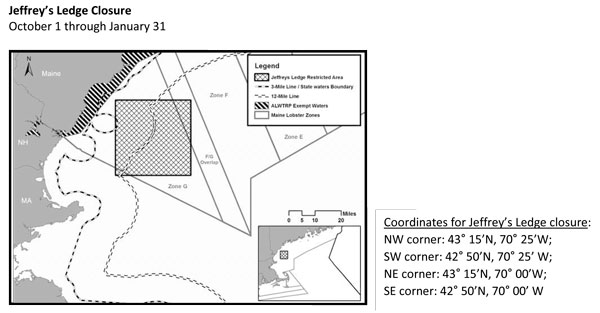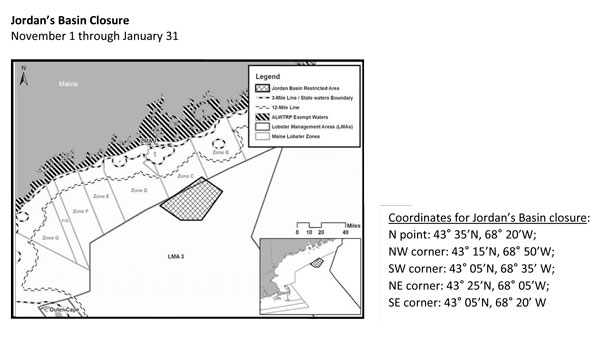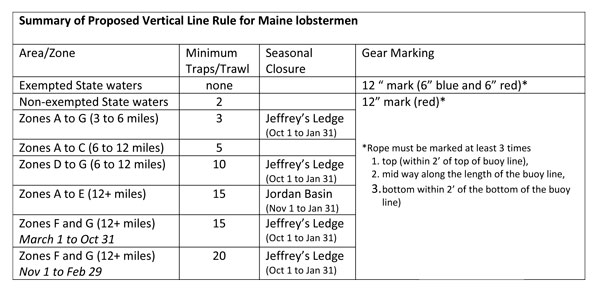Lobstermen Open to Area-Specific Endline Rules
continued from Homepage


Only a score or so of folks showed up for the Ellsworth hearing, and few commented. The primary speakers in Ellsworth were Department of Marine Resources (DMR) commissioner Patrick Keliher, Maine Lobstermen’s Association (MLA) executive director Patrice McCarron, and Downeast Lobsterman’s Association (DELA) president and Zone C chairman Hilton Turner.
“We’re pleased the proposed rule addresses fundamental concerns expressed by the Maine fishing industry and the Maine take reduction team delegation,” Keliher said.
McCarron commended NMFS for taking an area-based, strategic approach for the proposed vertical-line rules. She said this was a welcome contrast to the sinking-line rule implemented in 2009 – a broad-based, “one-size-fits-all” approach for the entire Atlantic coast.
“This plan is area-specific. It seeks to apply management measures where they need it most,” said McCarron. “I think that is definitely the right direction to go in.”
Under Alternative 1, NMFS would continue with the status quo.
For the Northeast Region (Maine-North Carolina):
Alternative 2 would increase the number of traps per trawl based on area fished and miles fished from shore (0-3), (3-12), and (12-plus). Maine waters are managed based on zone, and the proposed number of traps per trawl differ based on Maine zone.
Alternative 3 is a combination of NMFS’ proposed traps-per-trawl (Alternative 2) and ideas from states. Maine’s Department of Marine Resources provided a proposal for traps-per-trawl based on Maine zones and distance from shore (0-3), (3-6), (6-12), and (12-plus) that differ from NMFS. Massachusetts Division of Marine Fisheries proposed a closure in the Cape Cod Bay Critical Habitat area for all fisheries from Feb. 1 through April 30. Rhode Island Department of Environmental Management requested a minimum 15 trap-per-trawl requirement in Lobster Management Area (LMA) 2 (12-plus) as opposed to NMFS’ 20 trap-per-trawl limit. New Hampshire Department of Fish and Game requested that New Hampshire state waters be exempt from the plan.
Alternative 4 is the same as Alternative 2 with the addition of closures in certain area: Jordan Basin (Nov. 1 to Jan. 31); Jeffreys Ledge (Oct. 1 to Jan. 31); and Cape Cod Bay to Great South Channel (Jan. 1 to April 30).
Alternative 5 is a combination of Alternatives 3 and 4. Where proposed closures overlap (such as Cape Cod Bay) the larger closure in time and area is proposed.
Alternative 6 is similar to Alternative 5 but only includes one of the three closures proposed in Alternative 5.
All of the alternatives also include a more robust gear-marking program. Gear-marking proposed under all the alternatives would maintain current color combinations but increase the size and frequency of the mark. For the first time, a mark for Maine’s exemption area would also be required.
NMFS estimates the alternatives would reduce vertical lines by 28 percent to 38 percent.
The development of the vertical-line proposals was based on a model that determined the co-occurrence of fishing gear density and whale density, using fishing gear survey data from 2000 to 2011, and whale sightings.

The proposal to implement seasonal closures on Jeffreys Ledge and Jordan Basin were based on high co-occurrence and high use by whales in those areas. During the winter, recent aerial surveys have sighted aggregations of right whales in the central Gulf of Maine, according to NMFS. “The demographic composition of individuals suggests this may be a mating ground,” NMFS said.
The numbers of traps per trawl proposed are based on the co-occurrence model, discussions with the public, and NMFS’ state partners, NMFS said. In Maine, the traps per trawl were defined based on state lobster zones.
Gear-marking was first implemented in 1997 and currently requires fishermen to mark their buoy lines with one 4-inch mark depending on the area they fish. The colored mark is midway along the buoy line. Colors correspond to specific management areas designated by the plan.
The current gear-marking strategy is inadequate, NMFS said.
“From 1997–2008, there were 364 large whale entanglement events,” NMFS said. “Gear was retrieved in 129 of these cases; of the cases where gear was retrieved, gear-marking led to 36 cases where fishery, location, and date were known. A stronger gear-marking strategy would help answer questions such as when and where entanglements occur.”
The proposed gear-marking scheme would maintain the current color combinations but increase the size and frequency of the mark. The proposed new mark must equal 12 inches in length, and buoy lines must be marked three times (top, middle, bottom). The proposal would allow multiple methods for marking line (e.g., paint, tape, rope).
The ALWTRP was implemented in 1997. Since then, NMFS has modified it on several occasions. But entanglements continue.
From 1997 through 2010, humpbacks accounted for the greatest number of serious injury entanglements (35), followed by right whales (11), minkes (5), and fin whales (4).
During that same period, minkes accounted for the most known fatal entanglements (31), followed by humpbacks (20), right whales (8) and fin whales (6). Other threats to whales include ship collisions, water pollution, noise pollution, climate change, and reductions in prey.
Speakers said they supported some elements of the proposal, but not others. Keliher said his agency remains committed to working with NMFS and the Take Reduction Team to reduce the risk of entanglement. “However, this proposal does not establish any risk-reduction target,” Keliher said. With no target, it will be impossible to analyse the results of any of the measures, he said.
The proposed rule doesn’t define the coordinates of the six-mile trawl line that is an integral component of the gear modification alternative, Keliher said.
Keliher said his agency supports the proposed Maine-area-specific trawl minimum alternative. “It’s generally supported by industry and is an operationally realistic alternative that achieves over 30 percent reduction of endlines in the northern Gulf of Maine,” Keliher said. “This alternative considers local fishing knowledge and has resulted in risk-reduction strategy tailored for fishing areas, zones and regional fishing practices.”
However, Keliher said, the DMR opposes the proposed Jeffreys Ledge and Jordan Basin closures. “While we acknowledge the need to implement some level of conservative risk-reduction measures in high co-occurrence areas, closures should remain the last alternative to be used,” Keliher said.
For the Jefferys Ledge closure, the DMR proposed a substitution that would require additional trawling-up in Zones F and G between six and 12 miles and beyond 12 miles.
For Jordan Basin, the DMR proposed, at a minimum, modifying the proposed closure area’s northern boundary to the Area 1 and Area 3 lobster management boundary line, based on very low fishing effort in that area.
Keliher said that, in any case, all three proposed closures would only result in less than 5 percent co-occurrence reduction coastwide, and of that, only 2.5 percent would be attributable to a Jeffreys Ledge closure.
The closures would likely only result in fishermen relocating their gear, instead of suspending fishing, Keliher said. Therefore, the risk-reduction of any closure “is minimal at best, yet it would result in huge economic penalty to many fishermen from the state of Maine as well as New Hampshire and Massachusetts,” he said.
Keliher said the DMR opposed any increase in gear-marking in Area 1. At this point, he said, vertical line marking only informs researchers where the lines were originally deployed, not where the entanglement occurred. Expanding the current marking scenario for the entire Gulf of Maine would not increase the degree of accuracy to further reduce entanglements, he said. The DMR proposed that any increase in gear-marking requirements be suspended until after NMFS develops a more defined regional scenario.
The DMR also opposed increased gear-marking in the exemption area. In addition to the above rationale, Keliher said, the measure is “operationally unrealistic and cost-prohibitive in an area where documented sightings are rare, at best.”
Operationally, Keliher said, Maine’s endlines are fished in a combination of the exempted areas, the sliver area and federal waters. Measures with completely different marking patterns will require the industry to swap endlines as they routinely shift their gear between all the different fishing areas, he said.
“This is a cost-prohibitive and operationally unrealistic measure that will achieve nothing,” Keliher said.
McCarron said that, in terms of the trawling-up measures, the MLA supports Alternatives 3 and 5. But the plan must include coordinates for the six-mile line, she said. “The placement of that line needs to be at a point where the bottom is going to change enough where the guys can trawl up safely,” McCarron said.
McCarron said the Jeffreys Ledge closure is “a major concern.”
She said, “it is not do-able, and it’s not going solve issues for whales. People aren’t going to stop fishing. They’re going to move, and you’re going to take away economically valuable bottom. And the conservation measures won’t add up.”
McCarron said the rationale for a Jordan Basin closure makes more sense. And certainly, she said, whales are there and mating. But the MLA doesn’t agree the closure should dip into Area 1, for operational and enforcement reasons, she said. “If that closure stays on the books, it should truncate to the Area 3 line,” McCarron said.
McCarron went on to say the MLA is “hugely concerned” with the gear-marking scheme proposed for the exempted waters of Maine, which involves the use of different colors for the marks, depending on the area fished.
“It can’t be done,” she said. “We don’t have unique gear that is fished inside the exemption line and outside the exemption line. So if you’re looking to determine whether or not that exemption area is or is not impacting whales, this gear-marking scheme isn’t going to speak to that at all. It’s the same gear that’s going to move on both sides of the line.”
Both Keliher and McCarron said the implementation date of any new rule should be June 1, not in the autumn during the peak of the fishing season. DELA’s Hilton Turner said that trawling up to triples would be dangerous. “Pairs are hard enough to work with alone,” Turner said. “But you add that extra trap and things are happening quick. You have to step away from that steering wheel, because if you have your boat set, the third trap is set back so far that you have to step away from the steering wheel to get that third trap and set it into the water. With pairs and singles, he can hold his wheel the whole time. But with the third trap, he can’t. So there’s a danger. I could see if there were whales being caught in that area, in the state waters. But there aren’t. I don’t think I’ve ever seen a whale.”
With regard to the gear-marking proposal, Turner said he and others splice their colored line in, and it would be too difficult to change.
Likewise, MLA vice president Jim Dow, who fishes out of Bass Harbor, said he paints on his marks, making it impossible to get off. To replace ropes would be cost-prohibitive, he said.
Dow said he didn’t have a problem with Alternative 3. However, he said, he didn’t like the idea of the closures. At the least, if the Jordan Basin closure stays, it should stop at the Area 1 and Area 3 line, he said.
With regard to the trawling-up line at six miles, Dow said he would like to see the line extended around Mount Desert Rock. He said there’s an area there that he and five to seven other lobstermen fish.
“To fish five-trap trawls on that very hard bottom would be impossible,” Dow said. “It would be very dangerous. It’s very jagged bottom and it would be impossible.”
DELA director Mike Dassatt, noting that fishermen in his area are currently exempt from gear markings, said he was concerned about the prospect of gear-marking because tugs and barges pick up a lot of trap rope, which is later discarded offshore.
“Guilty by association is what I’m afraid of,” Dassatt said. “If that rope gets cut off from a barge down at the Cape, and ends up on a whale, they’re going to say, ‘Well, it’s the guys from Maine.’ It’s stereotype that I don’t feel is right to put on Maine fishermen, especially the guys in exempt waters, because you’re asking us to totally separate from the rest of New England. The cost to fishermen of doing that is astronomical.”
Julie Eaton, a lobsterman out of Stonington, urged NMFS to be cautious in working out the new rule. “I’m just a little fisherman. I fish 400 traps, all singles,” Eaton said. “Ninety percent of my gear, right now, is less than 30 feet. There are no whales in less than 30 feet. This is ridiculous. You’re applying pressure that certainly doesn’t need to be there. Please, please don’t cause us any more hurt, because right now the Maine lobstermen are hurting. We don’t need more expense. There isn’t one of us who wouldn’t help a marine mammal, but don’t kill us in the process.”
